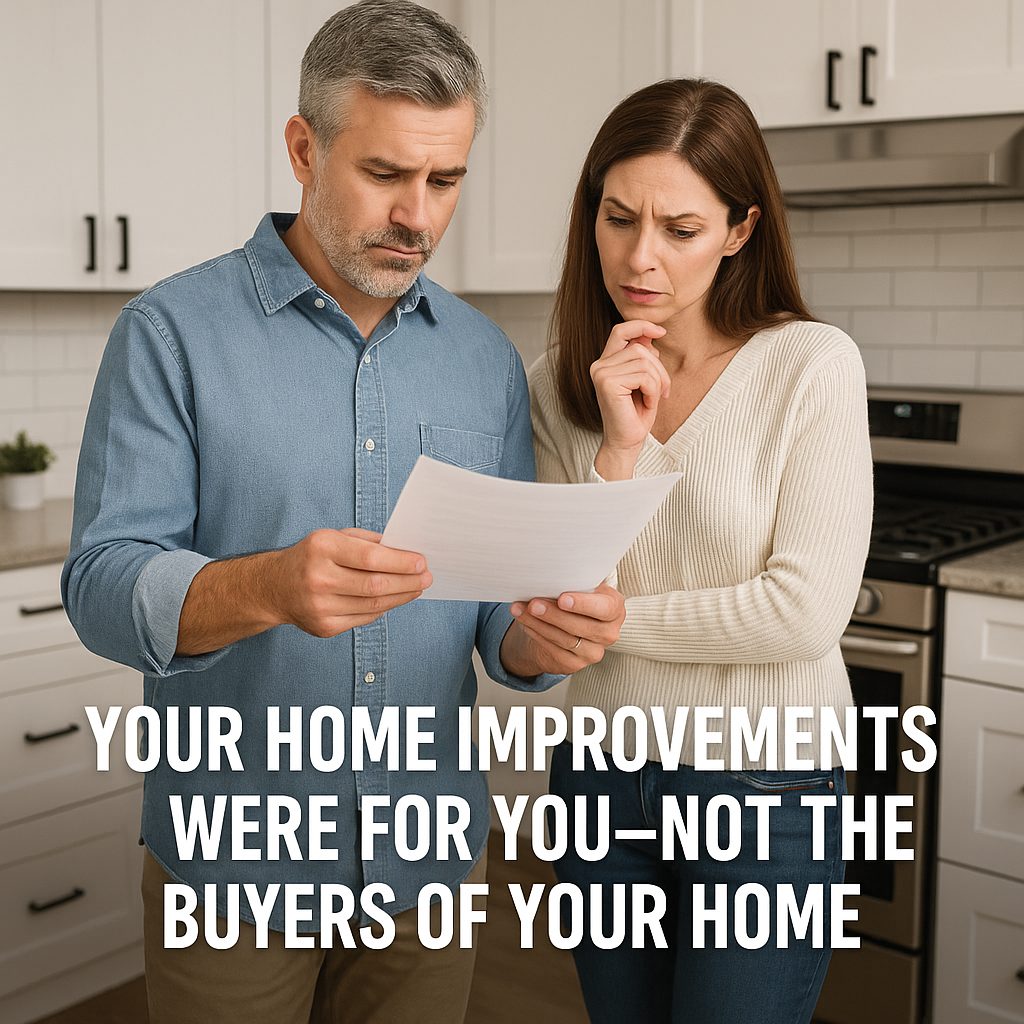Understanding the connection between home improvements and resale value is essential for every homeowner preparing to sell. While upgrades may enhance your lifestyle, not all of them increase your home’s market value. In many cases, improvements are made for personal comfort rather than buyer appeal. This gap often leads to pricing mistakes, longer days on market, and lost profit when it’s time to sell.
Your Style May Not Match the Market
Every buyer has their own vision. Custom features like a red kitchen, a sports-themed basement, or a built-in espresso bar may be perfect for you. However, for buyers, these details can feel like extra work or added cost to reverse.
Instead of picturing their future in the space, they may struggle to look past your personal choices. That hesitation can cost you offers—or worse, stop them from viewing your home altogether. This is a prime example of how home improvements and resale value can become misaligned.
Not Every Upgrade Pays Off
While updates can increase appeal, most won’t return 100% of your investment. The national average return on renovations ranges from 45% to 70%, depending on the project.
Here are some typical ROI numbers (source: Remodeling Magazine Cost vs. Value Report):
| Home Project | Average Return |
|---|---|
| Garage Door Replacement | 93% |
| Minor Kitchen Remodel | 71% |
| Bathroom Remodel | 66% |
| Major Kitchen Remodel | 56% |
| Home Office Addition | 45% |
As you can see, when considering home improvements and resale value, it’s important to understand which projects truly add market worth.
What Buyers Actually Want
Certain improvements do help sell a home. These tend to be neutral, functional, and easy for buyers to embrace:
-
Fresh paint in neutral tones
-
Clean, updated flooring
-
Simple, modern light fixtures
-
Energy-efficient windows and doors
-
A neat, landscaped yard
These features make a home feel move-in ready. They also help buyers imagine living there without needing to make changes right away. See more buyer preferences in this NAR report.
Focus on Function, Not Just Flash
Cosmetic upgrades may grab attention, but they won’t matter if the core systems are failing. A beautiful bathroom won’t offset a leaking roof or faulty wiring.
Instead, buyers want confidence in the structure of the home. That includes:
-
A solid roof
-
A working HVAC system
-
Modern plumbing and electrical
-
Updated insulation and windows
When evaluating home improvements and resale value, remember that functional updates often have a bigger impact than visual ones.
Don’t Be the Most Upgraded Home on the Block
Spending too much on upgrades in a modest neighborhood can backfire. When your home is priced well above others nearby, it raises concerns. Appraisers may not support the price, and buyers may walk away rather than stretch their budgets.
Rather than over-improve, focus on updates that align with your neighborhood’s value. You can learn more about pricing in your area from Zillow’s Housing Market Tracker.
Buyers Are Buying the Space, Not Your Story
Your upgrades may hold special meaning. That cozy sunroom where you had morning coffee or the custom shelves you built with care might seem priceless to you. But buyers are looking at square footage, layout, and future possibilities.
They want a blank slate. Your memories, while meaningful, don’t add monetary value to them.
Stage for Success
When your home is overly personalized, staging can help. The goal is to make it easier for buyers to picture themselves living there.
Simple changes include:
-
Repainting bold walls in lighter tones
-
Removing bulky or excessive furniture
-
Minimizing personal photos and decorations
These steps help the space feel open, clean, and buyer-ready. For more, visit the Real Estate Staging Association.
Cost Doesn’t Equal Value
Just because a project was expensive doesn’t mean it adds to your asking price. Many sellers fall into the trap of pricing emotionally. Buyers won’t care that your countertops cost $10,000 if the rest of the home feels outdated.
Pricing must be based on:
-
Comparable home sales
-
Market demand
-
The condition of your property
Let the market set the value—not your receipts.
How to Prepare for the Sale
Before listing your home, take a few smart steps to increase your chances of a quick and strong offer:
-
Get a pre-listing inspection to spot and fix big issues early.
-
Work with a knowledgeable Realtor to set a realistic, competitive price.
-
Declutter and clean to make your home feel bigger.
-
Tackle minor cosmetic fixes like replacing broken fixtures or repainting scuffed walls.
-
Boost curb appeal with mulch, trimmed bushes, and a clean entryway.
For a full checklist, see HGTV’s home selling tips.
Final Thought: Think Like a Buyer
Buyers want clean, functional homes they can move into with minimal stress. They care less about upgrades that suited your lifestyle and more about how the home fits theirs.
So instead of expecting dollar-for-dollar returns, think strategically. Make smart updates. Focus on your home’s strongest features. And always keep the connection between home improvements and resale value top of mind.


 Facebook
Facebook
 X
X
 Pinterest
Pinterest
 Copy Link
Copy Link

